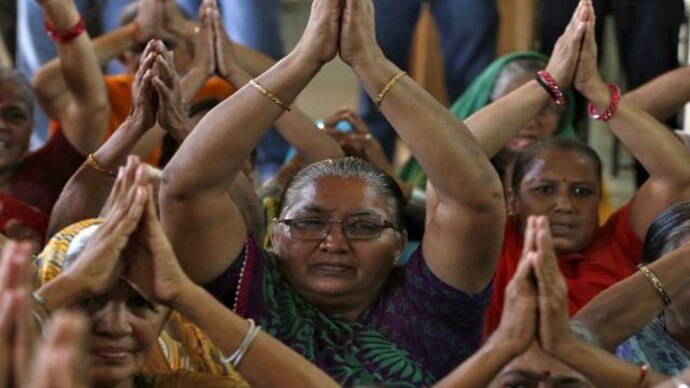Sabarimala question that SC constitution bench has to answer: Gender equality or faith?
The Supreme Court's constitution bench has to examine if the Sabarimala temple of Lord Ayyappa constitutes a separate religious denomination and enjoys protection under Article 26 of the Constitution.

Agreeing to the arguments of the Travencore Devasom Board, the Supreme Court today referred the Sabarimala temple matter to a five-judge constitution bench.
The constitution bench, among other aspects, has to decide the fundamental question if the Sabarimala temple of Lord Ayyappa - residing in Naishtika Brahmachari form- is a "separate religious denomination."
"This (decision) means that the Supreme Court's constitution bench now has to examine if the Sabarimala temple of Lord Ayyappa constitutes a separate religious denomination, a separate faith or sect and therefore, entitled to protection under Article 26 of the Constitution," said senior Supreme Court lawyer Atul Kumar.
Appearing for the Travancoore Devasom Board, senior counsel KK Venugopal had argued that the ban on women's entry in the Sabarimala temple was justified in tune with the tradition of the shrine. He argued that allowing women of certain age in the shrine would require reinterpretation of Article 25 and more importantly Article 26 of the Constitution.
"Article 25 guarantees freedom of conscience and free profession, practice and propagation of religion. Article 26 deals with the rights of a religious denomination," Atul Kumar said adding that the constitution bench "will give a fresh look at the scope of the two Articles."
Venugopal had also contended that the three-judge bench of Chief Justice Dipak Misra and Justices R Banumathi and Ashok Bhushan was not competent to interpret the relevant Articles.
Venugopal had told the Supreme Court that the issue of Sabarimala temple was complex and involved substantive interpretation of the Constitution under Article 145(3), under which the minimum number of judges required for hearing the matter was five. The Supreme Court concurred with the argument.
THE LEGEND OF SABARIMALA
The Sabarimala temple is situated in the Periyar Tiger Reserve in Kerala. Surrounded by 18 hills, the Sabarimala temple is one of the most visited shrines in the world. About 4-5 crore devotees offer prayer at the Sabarimala temple every year.
The Sabarimala temple is an ancient shrine which is believed to have been founded by Lord Parshuram. Lord Ayyappa is resting here as 'eternal minor' god. The god is believed to have taken a vow to remain celibate for eternity.
Ardent devotees believe that a visit to the Sabarimala temple by a woman of reproductive age will disturb Lord Ayyappa. Entry of girls of above 10 years and women under 50 years is prohibited in the Sabarimala temple. It is not clear as to when this practice began.
The Sabarimala temple has justified ban on entry of women of certain age saying that the restriction was enforced under Rule 3 (b) of the Kerala Hindu Places of Public Worship (Authorisation of Entry) Rules, 1965.
The Kerala High Court had upheld the ban on the entry of women aged 10 to 50 years in Sabarimala temple. The high court had held that the restriction was in place since time immemorial and not discriminatory under the Constitution.
DEMAND FOR ENTRY
But there have been instances when women entered the temple in the past. Gender-equality activists have been demanding that the restriction on entry of women should be lifted.
During the hearing of the case in the Kerala High Court, it was argued that despite the age-old practice, women used to go to the temple citing a visit by Maharani of Travancore in 1950.
In 2006, Kannada actor Jayamala claimed that she entered the temple and touched the idol of Lord Ayyappa in 1987 during the shooting for a film. Her revelation came after astrologer P Unnikrishna Panicker claimed to have found a signs of a woman having entered the sanctum sanctorum during a "devaprasnam". Later, authorities said that this was a propaganda to gain publicity by the actor.
However, the Sabarimala temple tantri performs a purification ceremony on the steps leading to the temple's sanctum sanctorum whenever the management observed that the rules were violated. The last such purification ceremony was observed in December 2011 when a woman managed to climb those steps.
MATTER IN SUPREME COURT
The Sabarimala temple debate reached the Supreme Court when a petition was filed by the Indian Young Lawyers Association challenging the restriction on women's entry upheld by the Kerala High Court.The petitioners challenged the Kerala High Court judgment on the grounds that it violated the fundamental rights guaranteed under Articles 14 and 19. They argued that the practice discriminated women against men and violated their right to equality.
However, the Travancore Devasom Board argued that the restriction did not discriminate women against men but women against women on the basis of age. This view has been held as regressive by gender-equality activists who said that the argument that menstruation did not make a woman impure.
The Kerala government's response has been baffling in this case. In 2007, the LDF government told the Supreme Court that it favoured entry of women of all age into the Sabarimala temple. But, last year, the UDF government changed its stand to say that it favoured the practice maintained by the Sabarimala temple.
After coming back to power last year, the LDF government has again said that it favoured changes in the practice of the Sabarimala temple allowing unrestricted entry of women of all ages in the shrine.
